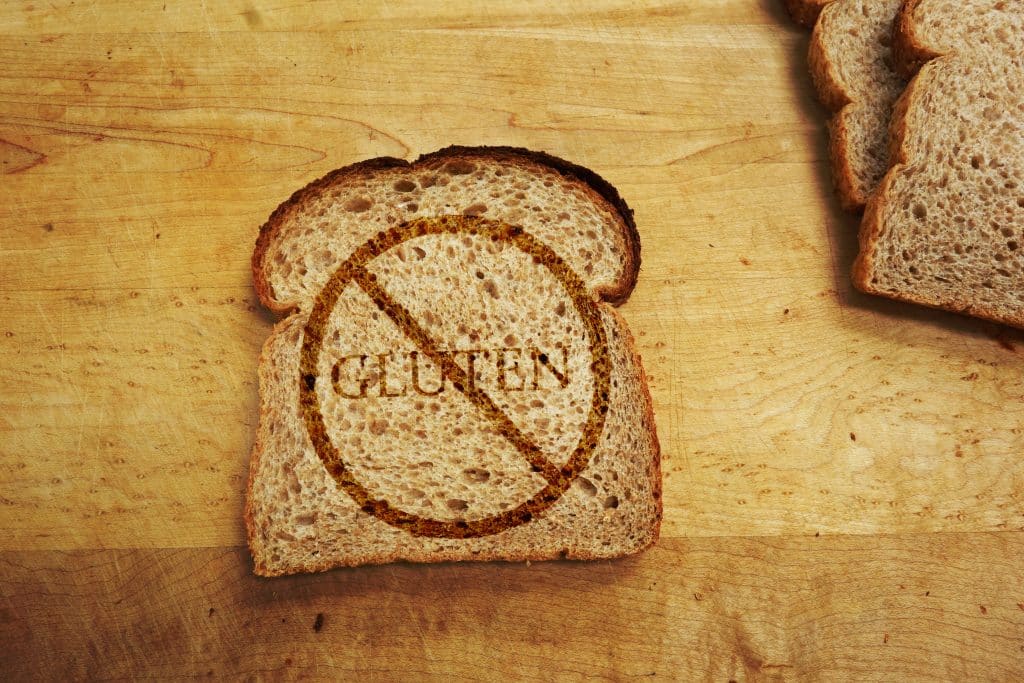
In recent years, apple cider vinegar has gained popularity for its numerous health benefits and versatility in cooking.
Likewise, many folks have chosen to follow gluten-free diets due to celiac disease, personal preference, or a gluten-sensitivity.
So whether apple cider vinegar is gluten-free has become increasingly relevant.
Apple cider vinegar (ACV) is primarily made from apples, which are naturally gluten-free. The short answer is that ACV should not contain gluten. The leading brand of ACV, Bragg’s, is gluten free:
However, as we quickly learned with my sister’s celiac disease, answers are rarely simple regarding whether something contains gluten. Gluten-free vinegars are not the exception, unfortunately.
There are variations in processing and the potential for error and contamination with allergens during production. Read on for the full explanation. (Or keep life simple and buy Bragg’s.)

Is Apple Cider Vinegar Gluten-Free?
Apple cider vinegar (ACV) is a popular vinegar derived from crushed apples, yeast, and sugar. It is commonly used in various recipes, particularly salad dressings, pickles, and marinades. Regarding gluten content, apple cider vinegar is considered gluten-free and safe for those following a gluten-free diet.

There are two main types of apple cider vinegar: distilled and non-distilled. Both varieties are generally suitable for individuals with gluten intolerance or celiac disease. Here is a brief overview of these types:
Distilled apple cider vinegar: This type undergoes a distillation process, which removes any potential gluten content. It is considered safe for those following a gluten-free diet.
Non-distilled apple cider vinegar: This variety is also naturally gluten-free, derived from apples rather than gluten-containing grains.
However, it is essential to check the labels for any potential sources of cross-contamination in the production process.
Other types of vinegars may not be gluten-free due to their sources, such as malt vinegar, rice vinegar, and corn vinegar. In addition, these types may be derived from gluten-containing grains, which can be problematic for those with gluten intolerance.
In summary, apple cider vinegar is a gluten-free option that can be safely consumed by those adhering to a gluten-free diet. Both distilled and non-distilled varieties of gluten free vinegar are generally safe, but it is crucial to read labels and be aware of potential cross-contamination risks.
Understanding Gluten

Gluten is a naturally occurring protein in several grains, including wheat, barley, and rye. It acts as a binder, providing elasticity and structure to various baked goods and other food products. Although gluten is harmless for most people, some may experience adverse reactions.
Celiac disease is an autoimmune disorder in which the immune system attacks the small intestine lining when ingesting gluten. This can damage the intestinal lining, causing malabsorption of nutrients and various symptoms, such as abdominal pain, bloating, diarrhea, and fatigue. About 1% of the population is estimated to suffer from celiac disease.
On the other hand, gluten intolerance, also known as non-celiac gluten sensitivity (NCGS), is another condition in which an individual may experience discomfort or digestive issues after consuming or eating gluten–containing products. However, NCGS does not cause the same autoimmune reactions or intestinal damage as celiac disease. Its symptoms range from mild to severe and can overlap with those of celiac disease, making it challenging to diagnose without medical testing.

Individuals with celiac disease or gluten intolerance must follow a strict gluten-free diet to prevent symptoms and potential health complications. A gluten-free diet excludes foods containing wheat, barley, and rye, among other grains, along with any derivatives or by-products derived from these grains. This includes malt, a common ingredient in various sauces, beer, and even some kinds of vinegar, such as malt vinegar.
In contrast, most other vinegars, like apple cider vinegar, distilled vinegar, balsamic vinegar, and wine vinegar, are generally considered gluten-free, as they are derived from non-gluten-containing sources or undergo distillation processes that remove gluten traces. Therefore, individuals on a gluten-free diet can safely consume these vinegars without causing any adverse reactions. Still, reading product labels thoroughly is essential, as flavored vinegar or seasoned vinegars may sometimes contain added gluten-containing ingredients.
Different Types of Vinegar
There are various types of vinegar used in culinary and other applications. The following paragraphs will provide an overview of some familiar and lesser-known varieties of vinegar.
Apple Cider Vinegar is typically made from apple cider and is considered gluten-free. It has a distinct fruity flavor, making it a popular choice for use in dressings, marinades, and even for health benefits.
White Vinegar, also known as distilled white vinegar, grain vinegar, or spirit vinegar, is derived from various sources such as corn, potatoes, rye, or grains. As a result, plain distilled vinegars are gluten-free even when made from gluten-containing grains. White vinegar is popular in pickling and cleaning recipes with its robust and unmistakable taste.
Balsamic Vinegar originates from grapes and is aged in wooden casks. This gluten-free vinegar has a sweet and tangy flavor, which makes it a versatile ingredient in cooking, salad dressings, and dipping sauces.
Wine Vinegar can be derived from red and white wines, resulting in red and white wine vinegar, respectively. Both types are gluten-free and add a distinct acidic taste to dishes, such as sauces, dressings, and marinades.
Malt Vinegar is made from barley malt, a gluten-containing grain, which makes it unsuitable for those following a gluten-free diet. This vinegar has a strong, distinct taste and is often used as a tangy condiment for many foods, fish and chips.
Rice Vinegar, as its name implies, is made from fermented rice and is gluten-free. It has a mild, slightly sweet flavor, making it a popular choice for Asian cuisine, particularly in sushi and dressings.
Cane Vinegar is derived from sugar cane and is a delicious gluten-free option. With a milder taste than distilled white vinegar, cane vinegar is often used in Filipino cuisine for pickling and preparing traditional adobo dishes with rice.
In summary, numerous types of vinegar exist for various culinary applications. Most vinegars are gluten-free, except for malt vinegar derived from barley.
Distillation Process and Gluten
The distillation process significantly determines whether vinegar, including apple cider vinegar, is gluten-free. Distilled vinegar typically undergoes a purification process that breaks down and eliminates gluten protein fragments, making the final product safe for those with gluten sensitivities or celiac disease.
In comparison, non-distilled vinegars, such as malt or rye vinegar, do not undergo this purification process and may contain gluten. This can make them unsafe for those who need to avoid gluten.
The gluten content in some distilled vinegars can be less than 20 parts per million (ppm), a threshold considered safe for most individuals with gluten intolerance. However, it’s essential to note that some experts question the accuracy of gluten testing technology, as it only sometimes picks up smaller fragments of wheat.
Here is a brief breakdown of common vinegar gluten types and their gluten status:
Distilled White Vinegar: Generally considered safe, as the distillation process removes gluten. However, there is some debate among experts due to possible cross-contamination during production.
Apple Cider Vinegar: Naturally gluten-free and safe for consumption. The distillation process removes any traces of gluten from the product.
Balsamic Vinegar: Like apple cider vinegar, balsamic vinegar is considered gluten-free, though there could be a slight chance of cross-contact during aging.
Malt or Rye Vinegar: Not considered gluten-free, as these vinegar types are not distilled and contain gluten.
To conclude, distillation is crucial in determining whether a vinegar product, like apple cider vinegar, is gluten-free. Checking labels and researching specific brands can help ensure the vinegar meets your gluten-free criteria.
Impact of Flavored Vinegars on Gluten Content
Flavored vinegars are a popular choice among consumers for adding taste to various dishes. However, their presence and impact on gluten content can be a concern for people with gluten sensitivities or celiac disease. This section will discuss the gluten content in flavored vinegars and their potential effect on digestion for those following a gluten-free diet.
Flavored vinegars can be derived from a variety of sources, such as fruits, herbs, and spices. Most types of vinegar, including cider vinegar, apple cider vinegar, wine vinegar, grape vinegar, distilled vinegar, white vinegar, and balsamic vinegar, are naturally gluten-free. However, it is essential to note that malt vinegar and some flavored vinegars are not gluten-free, as they may contain malt or other gluten-containing ingredients.
For instance, malt vinegar is derived from the gluten-containing grain barley and is unsuitable for people with gluten sensitivities. Additionally, flavored and seasoned vinegars may also contain gluten in the form of malt or wheat protein, which could pose a problem for those following a strict gluten-free diet. Therefore, reading the ingredient list carefully for any mention of gluten-containing ingredients when selecting a flavored vinegar is essential.
Some tips for identifying gluten-free flavored vinegars include:
Look for vinegar labels stating “gluten-free.”
Be cautious of flavored vinegars with ambiguous ingredient lists, as they may have hidden gluten sources.
If the label mentions wheat protein, it is not gluten-free.
Remember that the word “vinegar” on a food label typically implies cider or apple vinegar, which is gluten-free.
In conclusion, while flavored vinegars can add a unique touch to dishes, people with gluten sensitivities must scrutinize ingredient lists and adhere to gluten-free options to avoid potential health issues.
Gluten-Free Diet and Vinegars
When following a gluten-free diet, it is essential to understand which types of vinegars are safe for consumption. Vinegars are commonly used in various dishes and recipes, and knowing the difference between gluten-free and gluten-containing vinegars is crucial for those with celiac disease or gluten intolerances.
Apple cider vinegar is made from apples and is considered gluten-free. This vinegar is a popular choice for individuals on a gluten-free diet due to its natural source and potential health benefits. In addition, it is safe for those with gluten intolerance and does not pose any risks associated with eating gluten-containing foods.
In addition to apple cider vinegar, several other vinegars are considered gluten-free. Some examples of gluten free vinegars include:
Distilled vinegar (also known as grain vinegar, spirit vinegar, or white vinegar)
Balsamic vinegar
Wine vinegar (also known as grape vinegar)
These vinegars are derived from various sources, such as grapes, sugar cane, and corn, making them suitable for a gluten-free diet.
It is important to note that malt vinegar should be avoided on a gluten-free diet, as it contains malt derived from gluten-containing grains like barley. Additionally, soy sauce, often made from wheat, should also be avoided unless it is labeled gluten-free.
In conclusion, individuals on a gluten-free diet can safely consume apple cider vinegar and various other vinegar types as long as they are not derived from gluten-containing grains. By familiarizing oneself with the different types of apple cider vinegars and their sources, adhering to a gluten-free diet becomes easier and more enjoyable.
Preventing Cross-Contamination
It is essential to prevent cross-contamination when dealing with gluten-free diets, especially for those with intolerances or celiac disease. Cross-contamination can occur at home and in public spaces like grocery stores and restaurants. Here are some tips to minimize the risk:
Purchase certified gluten-free products: Look for labels that indicate the product is certified gluten-free, as these items are less likely to be contaminated with gluten during manufacturing.
Be careful in grocery stores: When shopping, be aware of the risk of cross-contamination between gluten-free and gluten-containing products. In addition, pay attention to shared equipment and storage areas. For instance, bulk bins can often be a source of cross-contamination.
Store gluten-free items separately: Designate a separate pantry shelf or storage area for gluten-free items to avoid accidental contact with gluten-containing products at home. Keep gluten-free grains, flour, and other products in sealed containers.
Use separate cooking tools and appliances: Keep different utensils, cutting boards, and dishes for gluten-free food preparation. Invest in dedicated toaster or toaster bags for gluten-free bread to avoid cross-contact.
Educate yourself and others: Become familiar with the most common sources of gluten and how to identify them on ingredient labels. Additionally, educate family members or housemates about the importance of preventing cross-contamination with gluten-free food.
Communicate with restaurants: When eating out or ordering takeout, communicate your gluten-free needs to the server, chef, or restaurant management. Ask about their methods for preventing cross-contamination and inquire about the ingredients used in their dishes.
By following these steps, healthy individuals with gluten intolerances can reduce the risk of unwanted gluten exposure and maintain the balance of a healthier gluten-free lifestyle.


